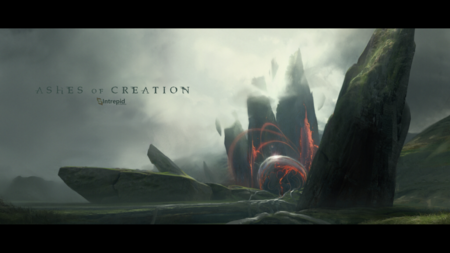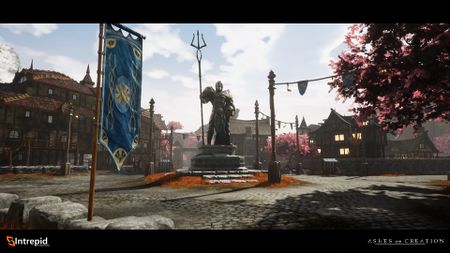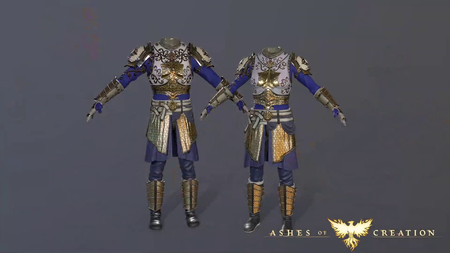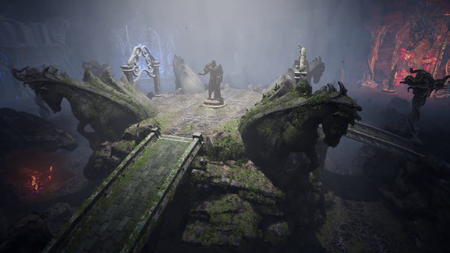Ihlet
Az Ashes of Creation több különböző MMORPG-ből merít inspirációt.[1]
- Eve Online-ból a regionális gazdaság és a kockázat jutalom ellenében elmélet ami a szállításban jelenik meg.[1]
- ArcheAge-ből az épület rendszer, szállítás és tengeri csaták.[1]
- Lineage II-ből a kockázat jutalom ellenében, vár ostromok, megjelölés, nyílt terű PvP és a céh fejlődés.[2][1]
- Star Wars Galaxies-ből a barkácsolás rendszer.[1]
Sok rendszer a Lineage 2-ből egy olyan elméleten alapul, ami ma már nem gyakori az MMORPG-kben: kockázat jutalom ellenében. Az elgondolás, miszerint minél többet kockáztatsz annál nagyobb jutalmat érdemelsz alapjaiban eltér a "mindenki győztes, mindenki kap részvételi díjat, nesze, gratulálok hogy játszol a játékkal"-féle rendszertől, ami unalmas. Nem ad semmi olyat amitől valaki törekedne hogy elérjen valamit, és megérezze a súlyát annak ha valamit elveszít. Az ilyenek miatt játszanak szívesen az emberek, és ezek hiánya miatt olyan rövid-életűek az újabb játékok, mert mindegyik a WOW-al versenyzik. Nem muszáj a WOW-al versenyezni. Nem muszáj WOW leváltónak lenni. Lehet helyette valami olyanra fókuszálni ami játék dizájn-filozófiai szempontból más; és szerintem ez az amit sok kiadó nem akar manapság megkockáztatni.[2] – Steven Sharif
Azzal kapcsolatosan hogy ezelőtt milyen volt, próbáljuk kideríteni hogy ki mit csinált a legjobban, és ebből inspirációt meríteni: előre léptetni a műfajt; megújítani amit kell, és a dolgokat a 21.-ik századba emelni.[1] – Jeffrey Bard
While Ashes of Creation took inspiration from Lineage II (and other games) it has also addressed several flaws in the implementation of those games.[3][4][5][1] The approach of the flagging system in Ashes of Creation is to further disincentivize griefing while still allowing the system to keep risk relevant in the open-world setting.[3]
- First and foremost, PvP in Ashes exists in both opt-in systems and events, as well as our open world flagging system. And while it is true that I enjoyed and took much inspiration from games like Lineage 2, we have innovated and adapted our approach to Ashes’ flagging system in order to further disincentivize griefing while still allowing the system to keep risk relevant in the open world setting. The overwhelming majority of player’s experiences with PvP in Ashes will be through consensual systems like caravans, sieges, wars, the open sea and other events. Players will make a choice to participate in those systems or not. And if they choose to participate there will be significant rewards for success.[3] – Steven Sharif
- Pvp in Ashes of Creation exists in both opt-in systems and events as well as open-world PvP with a flagging (and corruption) system.[3]
- In the open world, when competing for the scarcity of resources, raids, dungeons and or hunting grounds, an important element of risk vs reward is introduced through our flagging system. Players must be aware of their surroundings and the reputation of other players who may be in proximity. The flagging system is intended to always provide an element of risk in all settings, but also architected to ensure that griefing and PK’ing is almost never worth it. The subtleties of this system are complex, which is of course why it will require considerable testing and feedback.[3] – Steven Sharif
- Corruption gain takes into account level disparity between the attacker and the player that was killed. The greater the disparity the higher the corruption accrued.[4][6][7][8][9] Corruption penalties occur as the corruption is gained.[10]
- These are all things that I've changed in the system that help to safeguard some of those loopholes. Now of course, as we said, we can't and we don't want to 100% remove the ability for that risk to be alive- for that risk to be realized. But what we do want to do is make sure that those occasions are few and infrequent, and are not the majority of a player experience, let's say in the open world; and we do so by incorporating all of those risks and costs into a decision to gain corruption and then PK another player in the open world. It's just not going to be done often and that is my expectation and opinion. It's also the goal of the system is that griefing is not a viable option or play style. And as a result of that desire for the system, we will fine tune it in such a way through testing that that outcome is achieved. And that is the intent and purpose of the design.[11] – Steven Sharif
- Corruption score has a scaling impact on skill and stat dampening that will ultimately make them ineffective at PvP combat.[10][6][11][12][4][7][5][1][13][14][15][16][9]
- Working corruption off through XP grinding takes significantly longer than Lineage II.[4]
- There is also a bounty system that reveals corrupt player locations on the map.[4][5][17][18]
- Abilities with CC effects do not apply to non-combatants. This prevents players from opening attacks that stun unflagged players.[4]
- Players who heal, buff, or otherwise support corrupted players will flag as combatants.[11][19][20][21]
- There is a 60 second timer to logout while corrupt. Force-disconnecting the client during the cooldown will leave the character in-game.[11][22]
Dizájn
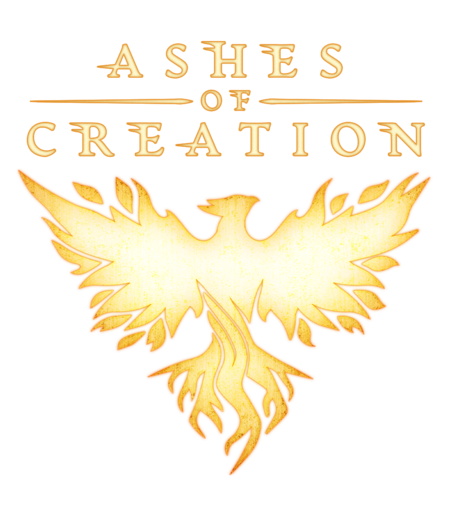
Az Ashes of Creation egy középkori fantasy világban játszódik, a képzelőerő és a korszerű grafika keverékeként. Az MMORPG kifejezésből a hangsúlyt a 'massive' szóra helyezzük, egyedi és újszerű játékmechanikákkal, amik értelmet adnak a játékosok tetteinek. A játék magába foglalja majd a hagyományos MMORPG-k legjobb részeit, innovációs sandbox elemekkel. Minden lehetőségnél a sorsodról döntesz. A küldetésvonalak elérhetősége a játékosoknak a világukkal való interakcióján fog múlni, mivel ebben a világban a cselekedeteknek következményei vannak. A szörnyek megjelennek, és egyre vadabbak, ahogy a civilizáció felveri a természetes rendet. A települések helyszínétől azok méretéig: te alakítod a világod tájait. Egyedi lesz kulturálisan, ökológiailag és gazdaságilag.[24]
Az Ashes of Creation egy közelgő MMORPG ami egy high fantasy világban játszódik, ahol a játékosok döntései alakítják és fogalmazzák a körülöttük lévő világot.[23]
Az Ashes of Creation egy egyedi MMO élmény. A világ szerkezete dinamikus, és a játékosok cselekedeteire reagál. Városok fognak virágozni és elbukni, míg a lakosságuk felépítését a világ történelme alakítja, amit a játékosok irányítanak. Ezen lakosságok gyarapodásával új küldetések válnak elérhetővé, a játékosok szükségletei növekednek, titkokra derül fény. Ahogy a világ NPC felépítése valós időben áll össze, a játékosok le is rombolhatják ami fel lett építve, megalapozva az utat újabb fejleményeknek, új lakosságoknak és valódi változásoknak. A politikai viszályok és érdekek valós szerepet fognak játszani a világ kialakításában. A statikus világok ideje lejárt, eljött a változás kora.[24]
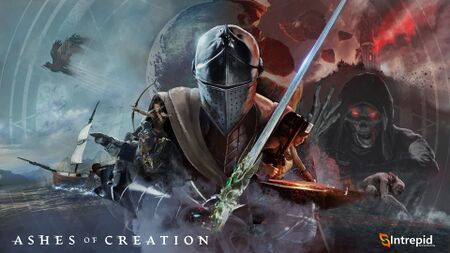
In order for sandbox mechanics to mean something, there must be curated content to accompany the player’s choices. Which means, as the developers, we must create that Themebox style content but for every possible path the community may take.[9] – Steven Sharif
Ashes of Creation is a PvX game built on the foundational principle of risk versus reward. The developers may seek feedback and make changes to portions of the game, but the core design pillars of the game will never be changed.[28][29][30][31][32]
- We will refine systems, we will iterate on systems, but we will never change the core identity of the intent and philosophical approach to what Ashes of Creation as an MMO brings to the MMO genre space... What we want to do is express that Ashes of Creation is endeavoring to build a risk-versus-reward centric PvX style game. And that intent and purpose will be delivered upon, and it will not change.[31] – Steven Sharif
- Ashes of Creation is referred to by the developers as a "themebox" or "sandpark" game as they aim to create a reactive player-driven world accompanied by curated content.[23][9]
- When it comes to how MMO’s have been traditionally designed, most gamers are familiar with two distinct types of gameplay loops: the “theme park”, and the “sandbox”. The vast majority of MMO’s we’ve all seen come and go in the gaming industry have been of the theme park variety – these games put the player onto a specific path, guiding them along, with plenty of pretty sights in between the same old quest hubs, very little in divergent paths, virtually no freedom in player progression. Recently the MMO genre has seen some games of the sandbox nature come onto the scene, but despite the ultimate freedom the sandbox affords players, many are left wanting more, as there is by definition no pre built world content, no human touch, just the vastness of the “sand” for lack of a better term. Thus many MMO players often find themselves caught between the repetitive rock of the theme park or the vast dead spaces of the sandbox’s hard place. This chasm between the state of MMO gameplay loops is where we intend to inject Ashes of Creation’s Node system.[23]
- Q: How do you go about designing some of the more old school systems such as XP debt, minimal fast travel, and open world raiding that have really gone away for the most part in modern MMOs?
- A: When looking at the reasoning behind why some of those old systems existed, a lot of it was centralized around the idea of risk versus reward. I mean, let's take a look at the three that you name, XP debt, minimal fast travel, and open world raiding. Experience debt is a cost of failure. Experience debt is the bite of not achieving success. If I die to a monster because my strategy was bad, because my performance was bad, because my planning was bad: all of that means that debt is the cost I pay for the bad choice... Minimal fast travel: My location matters; and the time it travels there is the cost I pay. Open world raiding: I'm not the only person interested in completing this objective. I have competition. That competition represents pressure. That pressure represents a desire to succeed and perform. All of those are touch points on player emotional connectivity. There is a reason why I want to succeed: Part of that reason can be incentivization through reward; part of that reason can be distance; it can be incentivization through failure. So that I think are one of the core fundamental philosophies as to how you design some of the more old-school systems.[33] – Steven Sharif
Dizájn pillérek
Az Ashes of Creation kivitelezése öt fő dizájn pillért követ.[34]
- A magával ragadó történet
- Reagáló világ
- Játékosi beavatkozás
- Játékosi befolyás
- Kockázat jutalom ellenében
In designing Ashes of Creation, we adhere every detail to five main pillars: Engaging and Immersive Story, a Reactive World, Player Interaction, Player Agency, and Risk vs Reward. Even in the environment, everything you as the player do will tie into these pillars, while everything your guild does, everything your server does will ultimately keep the world fresh, ever-changing, and most importantly... exciting.[34]
A magával ragadó történet
Témák amik Verra jelenéről és múltjáról szólnak.
- Kasztok, Archetípusok, Szerepek
- Fajok, Vallások
- Képességek, Augmentációk
- Történetek, Történetszálak
- Szerepjáték, Társalgási animációk
- Világtérkép, Érdek-helyszínek, Éghajlat
- Környezetek, Alvilág, Tengeralatt
Reagáló világ
Témák a világ fejlődésével kapcsolatosan, amit a játékos befolyásol.
- Node-ok, Node típusok, Node szintek, Node hatáskör(terület)
- Gazdaság, Piacok, Játékosi bódék, Árverőházak
- Szakmák, Gyűjtögetés, Feldolgozás, Barkácsolás
- Küldetések, Események, Feladatok
- Tengerészet, Tengeri harc, Hajók
- Világ boss-ok, Szörny érmék
- Rombolható környezet
Az Ashes of Creation világa egy élő, mozgásban lévő, reagáló világ. A cselekedeteid formálják a Node területeket, a Node-ok felszintezése hatalmas városokat állít fel, és megfogalmazza a történetet amit a játékosok átélnek.[37] – Margaret Krohn
Játékosi beavatkozás
Játékmechanikai rendszerek, amik elősegítik a játékosok közti interakciót.
- Dungeon-ök, Raid-ek, Harc
- Céhek, Céh házak, Céh erődítmények, Céh várak
- Csoport rendszerek, Loot-olás
- Hovatartozás
- Szervezetek
- Kocsmai játékok
Úgy döntöttünk, hogy a közösségszellemet elősegítő mechanikákkal foglalkozunk leginkább. Azért hogy értelmes játékosok közti interakció legyen - nem csak egyszerű dolgok mint meghódítani egy Raid Boss-t, vagy aprópénzt szerezni egy élettelen árverésházból, hanem megmenteni egy várost. Egy várost, ami fontos volt minden lakosa számára. Egy várost, ami hetek, hónapok munkájával lett felépítve; annak a városnak a megvédése, a támadás ami érte azt! Vagy egy világot közösségként felépíteni, együtt meghatározva a sorsunkat a barátainkkal. Szerintünk ezek a események messze emlékezetesebbek és jelentősebbek egy játékos számára, mint bármilyen történet amit mi kitalálhatnánk.[41]
Játékosi befolyás
Rendszerek amik a játékmenetet befolyásolják. Systems that grow and shape player experiences in the game.
- Fegyverek, Páncélok
- Fejlődés, Szintezés
- Házak, Node házak, Lakások, Birtokok
- Mount-ok, Öszvérek, Sárkányok
- Karakter készítés, Ruházat megjelenés
- Kinézeti tárgyak, Kinézetek, Jelmezek, Kiegészítők
- Leltár, Fogyaszthatók
Tömérdek tartalom lesz elérhető, eleinte elzárva, amit a játékmenet során tud majd a közösség feloldani. A hagyományos értelemben véve nem egy vidámpark vagyunk, viszont valószínűleg több tartalom lesz mint egy vidámparkban lenne, általában véve. Csupán azért, hogy az út során meghozott döntéseknek súlya legyen, az elért jutalomnak is jelentőséggel kell bírnia.[43] – Steven Sharif
Kockázat, jutalom ellenében
Bátor felfedezőket megjutalmazó, érdemes összetűzéseket eredményező tevékenységek.
- Világi PvP, Karavánok, Céh háborúk
- Node ostromok, Vár ostromok
- Játékosi megromlás, Fejvadászok
- Arénák
- Mérföldkövek, Rangsorok, Trófea díszkert
- Felfedezés, Kincsvadászat
- Tőzsdepiac
A kockázat kontra jutalom viszonyrendszer, amikor, például, időt fektettél egy Node felépítésébe, mások pedig hasonlóan időt fektettek Node ostrom eszközök építésébe, az egy kiélezett összetűzést fog eredményezni a játékosok között... Megéri nekik a befektetett idő, mivel szenvedélyesen érdekli őket ez a tartalom.[45] – Steven Sharif
Továbbiak
Hivatkozások
- ↑ 1.0 1.1 1.2 1.3 1.4 1.5 1.6 1.7 Interjú, 2018-08-24 (8:35).
- ↑ 2.0 2.1 Interjú, 2020-07-29 (9:02).
- ↑ 3.0 3.1 3.2 3.3 3.4
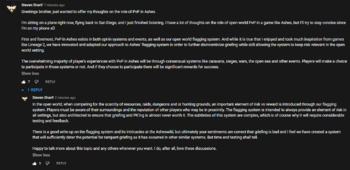
- ↑ 4.0 4.1 4.2 4.3 4.4 4.5
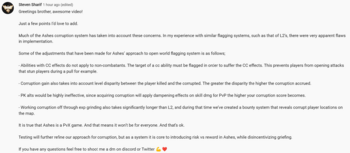
- ↑ 5.0 5.1 5.2

- ↑ 6.0 6.1

- ↑ 7.0 7.1 Interjú, 2020-07-18 (41:54).
- ↑

- ↑ 9.0 9.1 9.2 9.3 MMOGames interview, January 2017
- ↑ 10.0 10.1
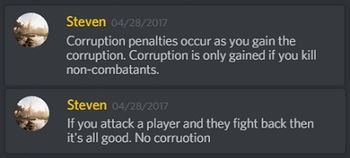
- ↑ 11.0 11.1 11.2 11.3 11.4 Élő adás, 2022-10-28 (26:48).
- ↑ Élő adás, 2022-10-28 (24:28).
- ↑ Interjú, 2018-05-11 (5:05).
- ↑ Podcast, 2018-04-23 (51:31).
- ↑ Élő adás, 2017-05-22 (42:33).
- ↑ Podcast, 2017-05-05 (43:05).
- ↑ Interjú, 2020-07-18 (44:35).
- ↑ 18.0 18.1 Interjú, 2017-04-27 (0:17).
- ↑

- ↑ Interjú, 2019-04-22 (54:40).
- ↑ Élő adás, 2017-11-17 (29:45).
- ↑

- ↑ 23.0 23.1 23.2 23.3 A reactive world - Nodes.
- ↑ 24.0 24.1 Ashes of Creation MMO.
- ↑ Video, 2019-08-20 (0:0).
- ↑ Élő adás, 2023-07-28 (1:30:11).
- ↑ Élő adás, 2023-04-07 (55:22).
- ↑ Élő adás, 2023-03-31 (1:00:16).
- ↑ 31.0 31.1 Élő adás, 2022-10-28 (32:52).
- ↑ Élő adás, 2017-06-01 (37:39).
- ↑ Élő adás, 2023-04-07 (40:30).
- ↑ 34.0 34.1

- ↑ Dillias diary.
- ↑ Élő adás, 2018-02-09 (33:50).
- ↑ Blog - Know Your Nodes - The Basics.
- ↑ Élő adás, 2018-01-18 (16:34).
- ↑ Élő adás, 2018-02-09 (4:42).
- ↑ Video, 2018-02-24 (0:01).
- ↑ Ashes of Creation - A new Beginning.
- ↑ Élő adás, 2019-09-27 (50:01).
- ↑ Élő adás, 2018-04-8 (AM) (27:26).
- ↑ Video, 2017-07-16 (0:01).
- ↑ Élő adás, 2017-05-22 (38:44).
